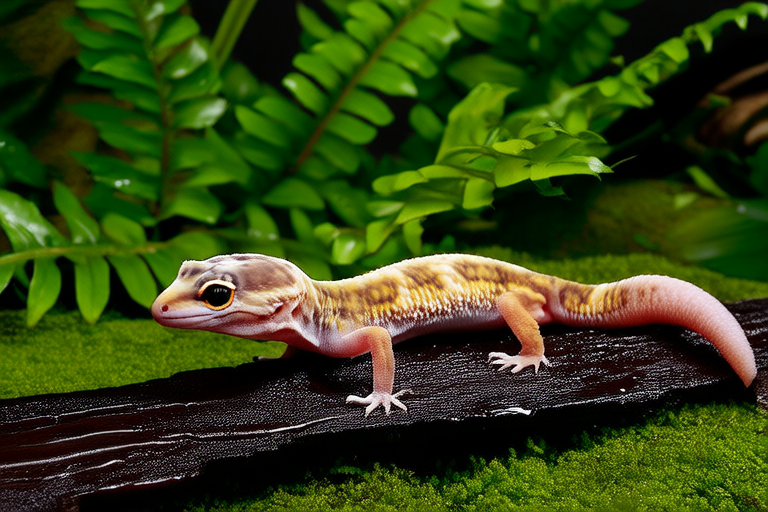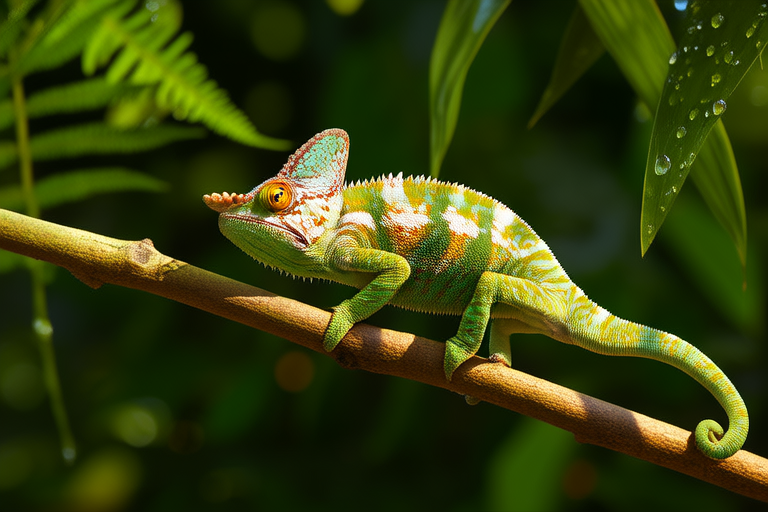
How to Care for Your Chameleon Like a Pro: Expert Tips
Welcome to the world of chameleon care! These fascinating creatures require specialized attention to thrive. This guide will help you provide top-notch care, from setting up their habitat to handling and socializing them.
Essential Habitat Setup
Creating an ideal environment is crucial for your chameleon’s well-being. Start with a spacious enclosure, at least 3 feet wide, 3 feet deep, and 4 feet high. Use non-toxic, natural branches for climbing, and ensure they’re arranged vertically to mimic their natural environment. Avoid using sand or gravel substrates, as they can lead to impaction. Instead, opt for newspaper or paper towels for easier cleaning.
Install UVB lighting to simulate sunlight, which is vital for calcium metabolism and overall health. Choose a 10% UVB bulb and place it within 6 to 12 inches of where your chameleon basks. Replace the bulb every six months to maintain its effectiveness. Supplemental heating sources, like ceramic heat emitters or basking lamps, should be used to achieve daytime temperatures between 85°F and 95°F (29°C – 35°C). Nighttime temperatures can drop slightly, but should not fall below 70°F (21°C).
Humidity plays a significant role in chameleon health. Maintain levels between 40% and 70%. Achieve this by misting the enclosure twice daily, ensuring water droplets are available for drinking. Alternatively, use a fogger or humidifier to create a consistent moisture level. Proper ventilation is also essential to prevent stagnant air and mold growth.
Proper Diet and Feeding Techniques
Chameleons are insectivores, primarily eating live insects. Offer a variety of prey items, such as crickets, dubia roaches, silkworms, and hornworms. Feed appropriately sized insects; a general rule is that the insect should not exceed the width of your chameleon’s head. Dust feeder insects with a calcium supplement twice weekly and a multivitamin once a week.
Feed your chameleon in a separate container to prevent accidental ingestion of substrate or other contaminants. Place insects in the enclosure for no more than 15 minutes to avoid stress and potential injury from overeating. Monitor your chameleon’s weight and adjust the quantity of food accordingly.
Forced feeding may be necessary if your chameleon is underweight or refusing food. Consult a veterinarian for guidance on safe techniques and nutritional supplements.
Maintaining Optimal Temperature and Humidity Levels
Temperature gradients are key to maintaining a healthy chameleon. Use thermometers and hygrometers to monitor conditions. Position your heating elements strategically to create distinct warm and cool zones within the enclosure. Regularly check and clean heating devices to prevent malfunction or overheating.
Humidity can fluctuate due to environmental factors. Invest in a reliable hygrometer and adjust your misting schedule or equipment settings to maintain consistent levels. Avoid excessive humidity, which can lead to respiratory issues. Conversely, low humidity can cause dehydration and skin problems.
Effective Health Monitoring
Closely observe your chameleon daily for any signs of illness. Look for changes in behavior, appetite, or physical appearance. Healthy chameleons are active, alert, and have clear eyes, smooth skin, and a robust stance. Any deviation from these characteristics warrants immediate veterinary attention.
Regular veterinary check-ups are essential. Schedule annual visits, and consult a reptile specialist for routine examinations and vaccinations. Keep detailed records of your chameleon’s health, including feeding habits, environmental conditions, and any observed behaviors or symptoms.
Common Diseases and Prevention Methods
Metabolic bone disease (MBD) is a serious condition caused by calcium deficiency. Symptoms include lethargy, swollen limbs, and difficulty moving. Prevent MBD by providing adequate UVB lighting, dusting prey with calcium, and ensuring proper humidity levels. If symptoms appear, consult a veterinarian immediately.
Respiratory infections are common among chameleons. Signs include nasal discharge, labored breathing, and lethargy. Maintain optimal temperature and humidity levels to prevent these infections. Quarantine new additions to your collection for at least two weeks to minimize the risk of introducing pathogens.
Parasites can also affect chameleons. Regular fecal examinations can detect internal parasites, while visual inspection can identify external parasites. Clean enclosures regularly and wash hands before and after handling your chameleon to prevent the spread of parasites.
Tips for Handling and Socializing Your Chameleon
Chameleons are solitary animals and do not require companionship. However, gentle handling can strengthen your bond. Always support your chameleon’s body when holding them, and avoid sudden movements. Allow your chameleon to become accustomed to your presence gradually, offering treats and speaking softly to encourage trust.
Handling should be limited to once or twice a week to prevent stress. Never handle your chameleon during shedding, as it may damage their skin. If your chameleon shows signs of distress or aggression, return them to their enclosure immediately.
Socialization with humans can improve your chameleon’s quality of life. Engage in regular, gentle interactions, and offer positive reinforcement through treats and praise. Over time, your chameleon may become more comfortable around you, enhancing your relationship.
Advanced Care Strategies
Implementing advanced care strategies can further enhance your chameleon’s well-being. Consider installing a drip system to provide a constant source of fresh water. This encourages natural drinking behavior and ensures your chameleon stays hydrated.
Incorporate enrichment activities to stimulate your chameleon’s mind and body. Provide hiding spots, rearrange branches periodically, and introduce novel objects for exploration. Rotate toys and decorations to keep your chameleon engaged and mentally stimulated.
Invest in a high-quality, programmable thermostat to maintain precise temperature control. Advanced lighting systems, such as timers and dimmers, can simulate natural light cycles and promote healthy circadian rhythms.
Conclusion
By following these expert tips, you’ll be well-equipped to provide exceptional care for your chameleon. Remember, each chameleon is unique, so tailor your approach to meet their individual needs. With dedication and attention to detail, you can ensure your chameleon lives a long, healthy, and happy life.





